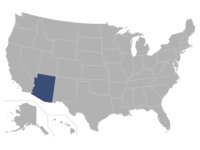AZ bears the brunt of voluntary Colorado River cuts, but water usage won’t be limited

Arizona’s water officials stand behind the proposal submitted by the Lower Colorado River Basin States, which prioritizes voluntary water conservation efforts from the state and tribal Nations, and say that Arizonans won’t need to use less water, even as the state will bear the brunt of cutting 3 million acre-feet.
Through the Lower Basin Plan, water officials stated that no one in Arizona would need to cut back on their water use, allowing the states some breathing room to find long-term solutions for the Colorado River.
“It’s a critical first step in securing our state’s water future for generations to come,” Gov. Katie Hobbs said during a press conference at the Central Arizona Project on May 25. She said the plan will provide immediate relief for the Colorado River Basin states and allow the states to refocus water conservation efforts beyond 2026.
“This is a great deal for Arizona, but we know long-term actions are needed,” she added.
The Lower Basin Plan, a consensus-based system conservation proposal, was submitted to the Department of Interior and the Bureau of Reclamation.
The proposal will conserve 3 million acre-feet of water and provide greater protections for Lake Mead and Lake Powell, Hobbs said, which is better than the alternatives analyzed in the Draft Environmental Impact Statement, a statement submitted in April proposing to revise the 2007 Interim Guidelines for the operation of Glen Canyon and Hoover Dams.
“Without this partnership, the federal government would have forced drastic cuts to Arizona’s water use,” Hobbs said, which would’ve happened through the Draft Supplemental Environmental Impact Statement.
Instead, Hobbs said the states could successfully negotiate voluntary conservation efforts that allow the states, cities, and farmers to have a say in their water future.
The Lower Basin Plan prioritizes early and significant contributions to reduce the risk of Lake Mead and Lake Powell declining to critically low elevations, according to officials, which it will achieve through voluntary agreements from a variety of water users from Arizona, California, and Nevada, including tribes, cities and agriculture.
“No Arizonans will be forced to reduce their water use,” Hobbs said.
Arizona Department of Water Resources Director Tom Buschatzke said the collaborative nature of the proposal submitted by Arizona, California, and Nevada is a testament to the state’s ability to find ways to protect Lake Mead and the Colorado River.
The Lower Basin Plan builds upon the excellent hydrology from this year’s snow season, Buschatzke said, and if the plan is adopted by the Department of the Interior, the elevation in Lake Mead will not just stabilize over the next three years, but will actually increase.
Bushcatzke said this will allow some safe space for the Lower Colorado River Basin States to negotiate what the Colorado River will look like when current operating guidelines expire at the end of 2026. Through this plan, Buschatzke added that they’ll go into those negotiations knowing that before 2026 the states will not end up in a crisis.
“Real challenges lie ahead in the coming negotiations,” he added, “but this agreement and the good hydrology we are seeing have created a strong starting point for all of us.”
Buschatzke said that Arizona will still do the bulk of the heavy lifting in water conservation, and they are looking at somewhere between 50% and 60% of the total water conservation productions, including new conservation efforts, will come out of Arizona. For California, it will be 30% to 35%.
“It is a work in progress,” he added.
The Gila River Indian Community has committed to significant water conservation efforts in the next few years as part of the Lower Basin Plan and the other agreement they’ve set with the State and an upcoming reclaimed water pipeline.
Gila River Indian Community Gov. Stephan Roe Lewis said that through the combined conservation agreements, and the reclaimed water pipeline, GRIC is set to contribute about 15% of the total conservation target of 3 million acre-feet of water.
Lewis said the modeling behind the Lower Basin Plan is an excellent deal for Arizona, tribes and the entire region.
“We have shown that Arizona can truly lead the way in finding creative and cooperative solutions to the thorniest of issues,” he said.
Lewis said the Gila River Indian Community is the single largest customer for CAP, indicating that each quarter about 25% of the water that goes through the CAP and transports to the Colorado River goes through to the Gila River Indian Community.
“We see ourselves modeling good behavior in the time of this historic drought,” Lewis said, and these water conservation efforts are essential to the Gila River Indian Community.
“There’s gonna be a lot of hard work ahead of us, but for the community, we’re in this because this is who we are,” Lewis said. “This is in our culture and tradition. To conserve, to be good stewards of the water.”








